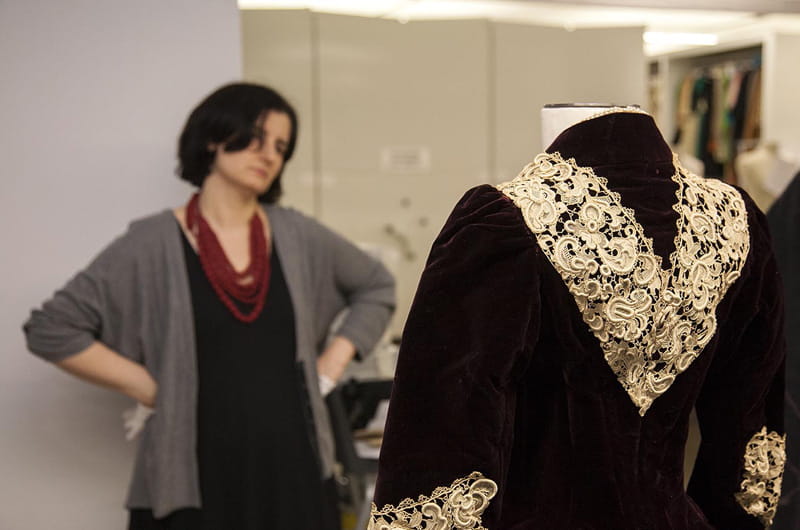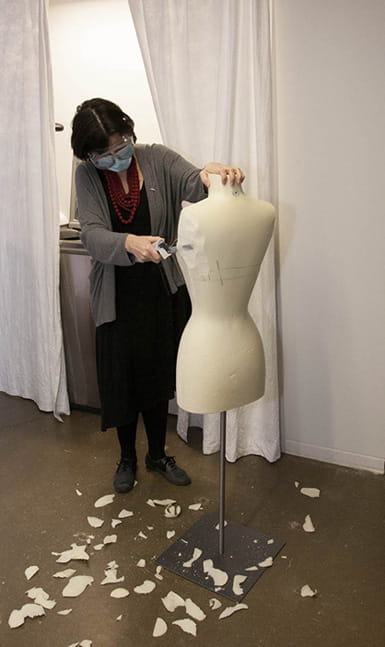Behind the Scenes: The Making of Immortal Beauty
 By Frank Otto
By Frank Otto
When it comes to preparing an impressive exhibit like Immortal Beauty, time is a factor.
Currently showing in the Leonard Pearlstein Gallery in the URBN Annex, Immortal Beauty: Highlights from the Robert and Penny Fox Historic Costume Collection is the debut exhibition for the collection. The 70 items on display span three centuries of fashion and design and will be in the gallery through Dec. 12.
For an exhibit like that, most museums would take a couple of years to plan it.
Clare Sauro and Cara Fry had just a year and a half.
“Two years is considered the standard,” said Sauro, curator of the Fox Historic Costume Collection. “So this was a bit of a compressed schedule.

Although Immortal Beauty highlights 300 years of glitz and glamour, Sauro, Fry (the wife of Drexel President John A. Fry) and their team put in the proverbial blood, sweat and tears to make the landmark exhibition happen.
“I have worked night, weekends, et cetera, for the better part of 2015 on the exhibition,” Sauro said, adding, “It is a good thing I love what I do.”
Hosting an exhibit like Immortal Beauty is no cheap endeavor. But the financial support for it actually stems from a lunch the Frys had with their friend Tom Cook. Cook heads the Richard C. von Hess Foundation, an organization that seeks to bolster the arts and humanities through philanthropic support.
“Tom, who has impeccable taste and an abiding love for the arts, was immediately struck by the caliber and mission of the Fox Collection,” Cara Fry said. “It wasn’t long after we first showed him the collection that the von Hess Foundation generously agreed to support our debut exhibition.”
With a grant secured, Sauro and Fry could really begin planning. But even just coming up with a list of pieces to exhibit is no easy endeavor.
“The collection is largely uncatalogued, so there is no centralized database to search for objects,” Sauro said. “It was very physical: Searching boxes, scanning aisles, trying to remember where things were located.”
But putting together an exhibit doesn’t just stop at pulling dazzling garments and jewelry.
“Once I had a good list of contenders, I had to group them thematically — by period, in this case — and see how they looked together,” Sauro explained. “The groups had to work intellectually and also aesthetically. If the group didn’t work, I would return to the search.”

“Given the nature of the ‘highlights’ show, we were able to show off some of our most special pieces,” Fry said. “So, for this particular exhibit, the only real difficulty was in keeping the number of selections appropriate to the gallery space. There were many beautiful things that didn’t make the final cut.”
One of Sauro’s favorites is a pair of jeans that had been worn to Woodstock. But since they were men’s apparel and every other piece selected for Immortal Beauty was for women, they’ll have to wait for a future exhibit.
Many pieces that were chosen needed “stabilization” — stitching and reinforcing weak areas — to be safely exhibited.
Additionally, there was a unique problem that came with exhibiting clothes worn in the distant past: Modern-day mannequins are too big.
“People in the past were generally smaller and women modified their bodies with waist-cinchers, corsets and other items,” Sauro said. “This means it is nearly impossible — and damaging for the antique garments — to dress them on a modern commercial form.”

To remedy that, the collection bought foam mannequins and then hand-carved them to fit the garments. The process could take a few hours for each mannequin. Multiply that by 45 and you’ve got a pretty labor-intensive job.
On top of Sauro’s and Fry’s efforts, the exhibition utilized several different designers, a research co-op, photographer and conservator, among others.
Now able to see the results of their work, the Fox Collection team can see they’ve put together an exhibit that gives Drexel extra gravitas in a year when its fashion and design programs in Westphal College of Media Arts & Design were repeatedly recognized among the best in the country.
And when it comes down to it, Immortal Beauty accomplishes what the collection was brought to the University to do: teach.
“As an art historian, I was drawn to the collection from the first time I saw it,” Fry said. “I’ve always been fascinated by the concept of art as artifact. And fashion — the way in which people choose to present themselves — reveals so much about people as individuals and society as a whole. Each of these pieces tells a story.”
This piece first appeared in Drexel Quarterly's Fall 2015 issue.
In This Article
Drexel News is produced by
University Marketing and Communications.
